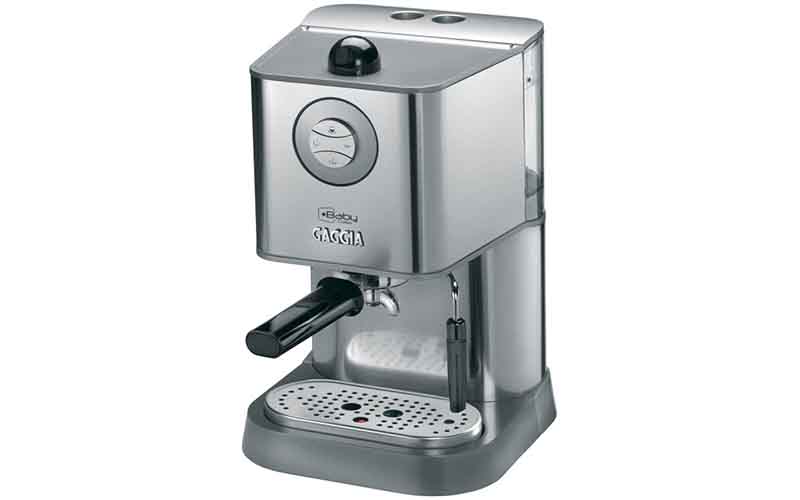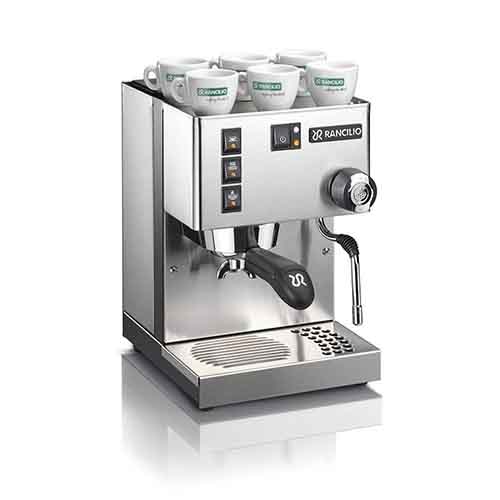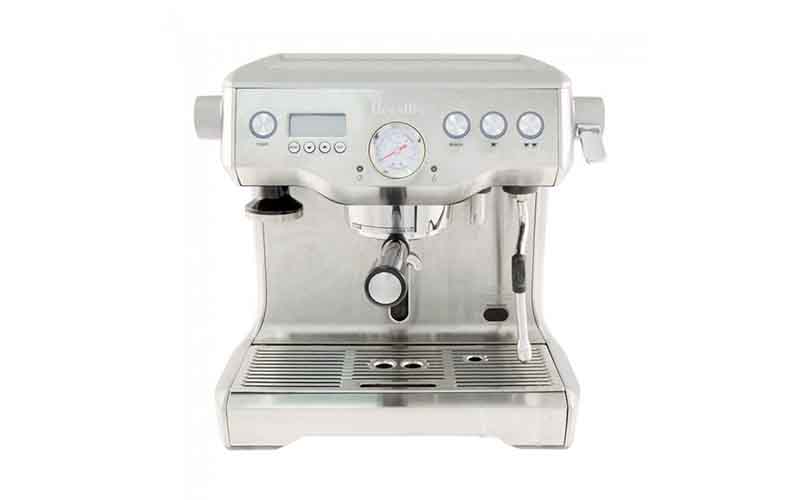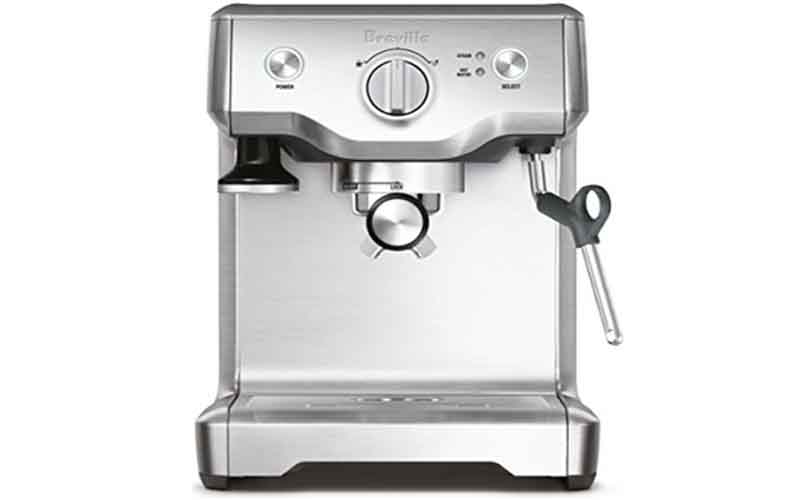Commercial Espresso Machine
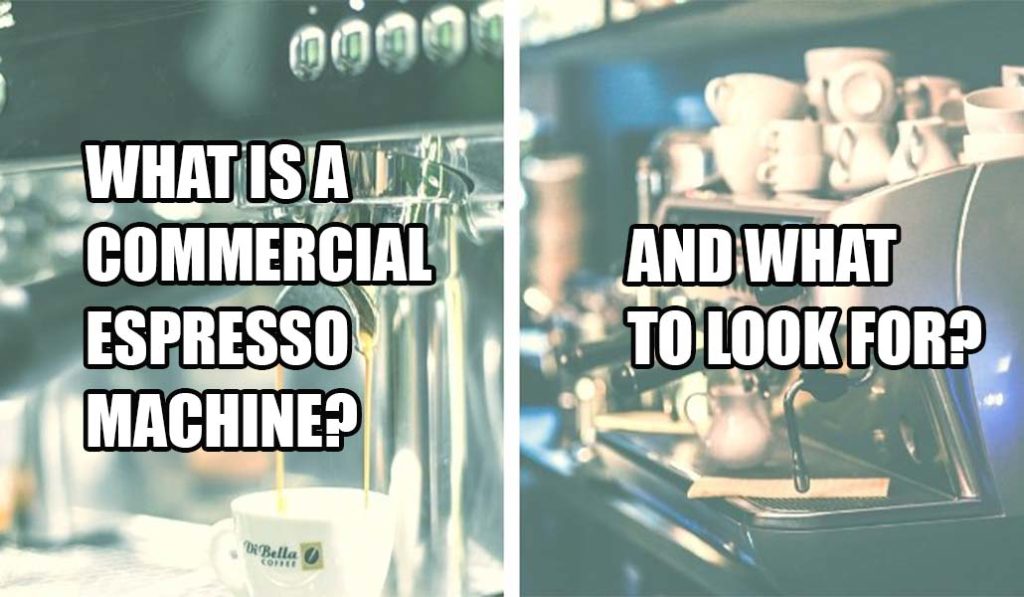
What Is A Commercial Espresso Machine?
A commercial espresso machine is used in business for mass production of coffee beverages, simply by using hot water and ground coffee with pressure creating shots of espresso. Most common types are semi-automatic and super-automatic.
Most appliances are industrial grade used in both cafes and restaurants. The steam wand provided can be used for steaming milk for cappuccinos and lattes as main ingredient.
Brief History
Angelo Moriondo originally invented the espresso machine in 1884, he patented a combination of tightly packed coffee grounds, steam, and high pressure. This lead the way for the modern espresso machine we know of today!
In 1901 improvements were made by Luigi Bezzera, if your thinking of Bezzera espresso machine you would be correct. By simple improvements, furthermore claiming he was only a mechanic and not an engineer he patented the new design. This took place on December 19th that same year.
His patents were granted nearly a year later in June 5th 1902, and gained interest by Desiderio Pavoni who bought the patent shortly after. After many design attempts four years later he began creating espresso machines. Hosting small workshops and creating variating designs eventually in Milan, Italy.
During the 1950’s England brought espresso machine over, beginning a worldwide love of coffee and spread into the United States. One of the largest coffee shop chain Starbucks adapted to the espresso machine during the 80s and 90s inventing many drinks on their staple menu items we all know today.
What Are The Main Types Of Espresso Machines?
The most common types of commercial espresso machines are classified into 4 categories listed below!
1.Manual/Lever or hand operated – preferred by some professional baristas as you can control the espresso shots being pulled. Commonly used in Italy and Europe
2. Semi-automatic – operator must tamp the coffee grounds into portafilter and required to manually stop the espresso when “pouring”. However, newer versions come with an “electric pump” and older version has a “hydraulic” delivery method
3. Automatic/Volumetric – same as semi-automatic, except the machine stops the length of pour depending on the size picked. The brewing duration is controlled and water levels monitored with sensors
4. Super-automatic – this machine does everything by the touch of a button. Grinding from whole beans, tamping the grounds, brewing, and removing the coffee grounds into a tray.
How Do You Choose The Right One?
1. Determine if you want semi-automatic or automatic – by the amount coffee beverages your shop will be making,
2. What is the brewing capacity – features to consider in commercial machines is the number of groups, boiler size, and steam available to froth milk.
One grouphead is able to produce up to 70 coffee beverages per hour, and capable of steaming enough milk for 4 restaurant sized cappuccinos at a time
3. Ease of use and maintenance – what is the skill level of the staff, this will be a major consideration in deciding which machine to purchase. If you want consistent coffee and drawing customers back, each order needs to be made quickly and efficiently.
4. Type of coffee drinks you are offering on your menu – look at the menu and choose if the machine is right for you, decide if 50% or more of the beverages include espresso. This will determine the size and group heads required.
Gaggia Baby Twin Single Boiler
Improve reliability and performance. Less likely to leak then spring activated valves and at lower costs. Comes with a pressurized and non – pressurized basket which allows you to grow with experience.
Rancilio Silvia Espresso Machine MV5
Allow 15 – 30 seconds between brewing and steaming as the machine comes up to temperature. After steaming the machine needs adequate cooldown time before brewing again.
Tips: If your using a non-pressurized basket, having a proper burr grinder is essential.
Breville Dual Boiler Espresso Machine
This allows you to brew and steam at the same time and as
you reach the higher models of commercial espresso machines a thermosiphon return is added giving you the ability to pull consistently repeatable shots.
Dual boiler prosumer espresso machine – has a separate brew boiler and steam boiler allowing consistent temperatures for multiple espresso shots.
Breville Dual Boiler Prosumer
How Much Does a Commercial Espresso Machine Cost?
Normally the price of commercial coffee machines starts from $1,000 and goes over $40,000 depending upon their features and facilities. You can find commercial machines from basic models to scientifically advance models with various features. They can not only make espresso coffee but also grind fresh coffee beans, steam and brew coffee along with flavoring the cup of coffee by adding certain syrups.
The cost of basic model of commercial coffee machine starts from $1,000 and the cost of some of the top models available in the market can be more than $40,000. However, the average price of a good quality commercial coffee machine can be around $5,000 to $6,000.
This variation in the price of coffee machines depends upon the tasks you want from your machine to complete. It can cost higher if the machine has a number of advanced features. So the cost of a commercial coffee machine can depend upon the number of coffee cups made by it in a day or an hour as well as the features it has to satisfy the customers of a restaurant or coffee shop.
How To Use Commercial Espresso Machines?
It is very easy to use a commercial espresso machine when you become used to it, initially you will have to remember the steps to use it perfectly. Proper grinding of beans, correct ratio of water and coffee and the correct amount of time to pull out the shot are some of the most important steps to keep in mind while using a commercial coffee making machine.
Steps to Use a Commercial Espresso Machine
1. The first step to use your commercial coffee machine is to ensure that the portafilters of the machine are present in the group of the machine’s head before you use it. It will keep them hot to pull a shot perfectly
2. When pulling a shot you should remove the portafilter from the machine to clean it, if any residue is left over in it
3. Use freshly ground coffee beans and have a grinder to grind coffee beans You should clean the group head of the coffee machine to drain out if any less warm water is present in the water line of your machine, before attaching the portafilter to the machine again
4. Move the portafilter in a circular motion to level the ground coffee beans. You should remove the crumbs of ground coffee fond around the edge of the portafilter
5. The ground coffee beans should be filled evenly before attaching the portafilter to the group head
6. Now attach the portafilter again to the group head It is instantly start brewing shot in the glass of coffee
7. While pouring shot into the glass you should be vigilant so that the volume of espresso coffee does not exceed the required level
8. Now take an espresso coffee cup and pour the shot into it The espresso coffee is ready to serve. Before serving it put a saucer under the cup and a spoon in the sauce
Check Out These Other Articles On CoffeeBrat
What Espresso Machine Does Starbucks Use? Can You Buy One?
How To Make Traditional Turkish Coffee? – Is It Stronger Than Espresso?
How To Make Strong Coffee – What Is The Best Brewing Method?
Where To Buy Robusta Coffee? – What Are The Best Types?
12 Different Types Of Coffee – What Are They?
What To Consider When Purchasing A Commercial Espresso Machine?
- How many cups of coffee are you producing each day?
- What is the variety of coffee you offer on the menu?
- Is your staff trained Baristas? and what is the skill levels?
What’s The Difference between Semi-Automatic and Super-Automatic?
Trying to pick out a coffee maker is hard enough, buying an espresso machine is even more difficult and limited options for home espresso brewing can be complicated.
One of the main differences between Semi-automatic and Super-automatic is the price point, on average Semi-automatic ranges from $200-$3000 depending on the brand and models. The average price point for a Super-automatic range from $850-$5000.
Semi-automatic takes a bit more work having to grind and tamp the coffee, then properly fit it into a portafilter before turning the machine on.
Manual or semi-automatic espresso makers don’t include a Burr Grinder, but a fully automatic do (one reason why semi-automatic are cheaper)
What Is A Semi-Automatic Espresso Machine?

Semi-automatic espresso machines force hot water through ground coffee under pressure to produce an espresso, this includes producing
steam for milk-based drinks such as lattes and cappuccinos.
Semi-automatic espresso machines are classified into 4 categories
Single Boiler espresso machines – come with a pressurized portafilter, takes the grind and the tamp out of the equation. Espresso won’t start brewing until proper pressure inside the portafilter has been reached.
Top 4 Commercial Espresso Machines
What Is A Super Automatic Espresso Machine?
A super automatic espresso machine makes espresso-based drinks built in a one or two-step system. The two-step system requires you to manually pull the shot.
4 major components make up the Super Automatic Espresso Machine
The Bean Hopper – a grinder located on top of most espresso machines. This includes a bypass dosser which gives you the option of choosing pre-ground or decaf.
What To Consider – a larger hopper, this will require you to fill whole coffee beans less frequently and an airtight seal preventing beans becoming stale.
The Grinder – based on coffee drinks being made the grinder dial can be adjusted accordingly.
Espresso Shots and Lighter Roasts take a finer grind, Darker Roasts and coffees which require Longer Brewing Times take a coarse grind.

Two most common types of grinders are “Conical Steel” or “Flat Ceramic“. Flat ceramic transfers less heat grinding the coffee beans which preserves flavor and operates quieter.
- Brew groups – manufacturers use the same brew groups from machine to machine, the only difference is some are removable while others are not.
- A typical warranty is between 1 – 2 years on removable brew groups and up to 3 years on non-removable brew groups.
- The Spout – brews 1 – 2 cups of espresso at a time depending on the model, and the height can be adjusted for all sizes.
Final Thoughts
Overall, buy a machine that accommodates the needs of your business. Consider the number of coffee drinks made per day, and this will determine your circumstances!









